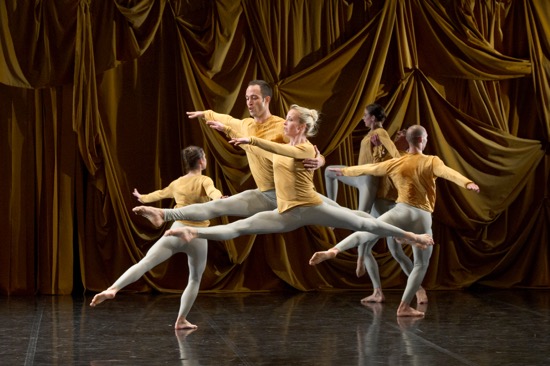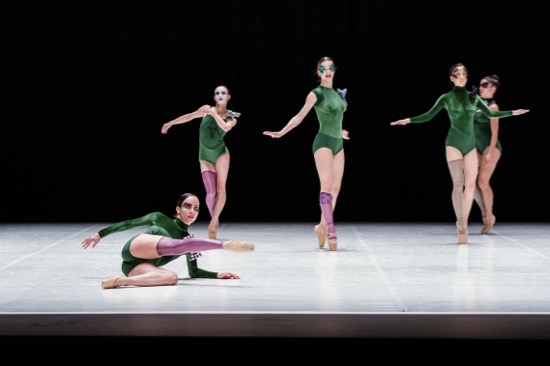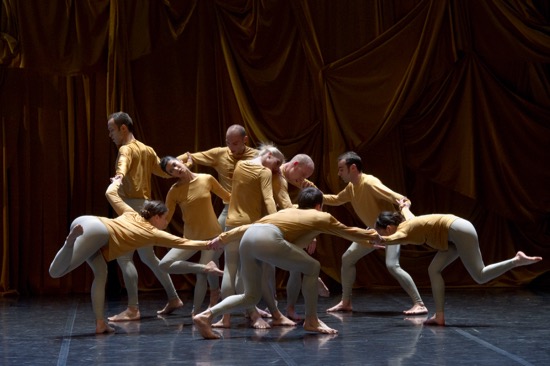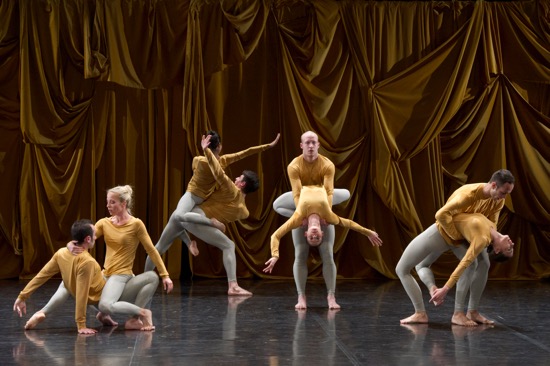CCN – Ballet de Lorraine presents three works from its repertory at the Joyce Theater.

Members of the CCN – Ballet de Lorraine in Merce Cunningham’s Sounddance. Photo: Laurent Philippe
In 1984, France’s Ministry of Culture decentralized dance. No more choreographers holed up in Paris while the rest of the country, for the most part, did without. To date, France has nineteen Centres Chorégraphiques Nationaux, almost all of them headed by choreographers of consequence. The Ballet de Lorraine, which just finished an engagement at the Joyce Theater, is one such institution.
Petter Jacobsson has been the artistic and general director of this repertory company, based in Nancy, since 2011, and his bio conveys something about his wide-ranging interests. He was a principal dancer in Britain’s Sadler’s Wells Royal Ballet from 1984 to 1993, after which he came to New York, studied with Merce Cunningham, and worked with Twyla Tharp, Irene Hultman, and Deborah Hay. From 1999 to 2011, he was the artistic director of the Royal Swedish Ballet, in whose school he had studied as a child. Oh, and he graduated from the Vaganova Academy in St. Petersburg. His artistic collaborator, Thomas Caley, danced (memorably) in Cunningham’s company for about six years.
So it’s not surprising that the experimental and the neoclassical mingled in one of the two programs the CCN – Ballet de Lorraine brought to the Joyce. The evening I attended featured three works: Devoted (by Cecilia Bengolea and François Chaignaud), Hok Solo Pour Ensemble (by Alban Richard), and Merce Cunningham’s 1975 Sounddance, reconstructed by Caley and Meg Harper.
The effect of this programming was, in a sense, cataclysmic. Imagine two dances whose focus on repetition made me think of 1970s works by Lucinda Childs and Laura Dean, followed by the explosion of wildly changeable movement and music that is Sounddance. It was as if Devoted and Hok Solo Pour Ensemble were gears cranking up their patterns and steps until you were ready for Sounddance and the kind of release that made you sit up straighter and try to get your eyes under control.

Five of the nine women in Cecilia Bengolea and François Chaignaud’s Devoted. Photo: Arno Paul
Devoted is set to music for organ and chorus, drawn from Philip Glass’s Another Look at Harmony Part IV (1975). Rhythm sustains melody and harmony. The nine women who perform it are garbed in bright green leotards of varying cut; some of them have large, asymmetrically attached bows. Most wear one translucent legwarmer, and all of them are on pointe. Bengolea and Chaignaud designed the costumes and probably the bizarre makeup. Jean-Marc Segalen’s lighting creates shifting horizontal paths—now downstage, now upstage—while the women lay out their patterns. Their movements are basic; for instance, running or walking on pointe, leaping, swinging one leg around, spinning or whipping into chains of turns with their flat palms facing down on either side of them.
Pretty soon, I find myself memorizing the steps and looking for the rules that alter the pattern. Now the women form trios. Now all are in unison. Now Sakiko Oishi (I believe), alone onstage, lays out some steps. Complexities build. And it’s eventually in blazing light that the women re-introduce sliding to the floor in splits and recovering into a jazzy skip. The music ends, but the dancers keep going. It makes you think that they could keep doing this all night. On one hand, watching Devoted is like watching a sophisticated machine with no known purpose stitching away. But the piece also makes you imagine the glamorous devotees of some strange health cult working out together.

CCN – Ballet de Lorraine dancers and musician in Alban Richard’s Hoc Solo Pour Ensemble (wearing other costumes than those used at the Joyce). Photo: Arno Paul
Hok Solo Pour Ensemble also can be considered in relation to minimalism. It is named after the 1976 Hoketus by the composer Louis Andriessen, which, in turn refers to the medieval process of hocket, in which, according to Wikipedia, “a single melody is shared between two (or occasionally more) voices such that alternately one voice sounds while the other rests.” Andriessen’s recorded work consists of two quintets that never play simultaneously.
There’s no glamor here. The seven women and five men who perform Hok are clad identically in black jeans and baggy gray tee shirts. And they announce Richard’s choreography as also spare. Facing us in a line, the dozen dancers ring changes on stepping forward and back, while bending over and straightening up. As they incorporate arm gestures, the line splits in various ways. It’s striking to see how when two, then three groups are walking, they can sieve through one another without breaking stride or altering the spacing between dancers. The performers are precise and expressionless; they could be symbolic of an orderly society in which individualism is a sin.
They become more intermittently diverse as the music grows from simple statements to complexity and power. Although they’re often waiting in a line or moving in a phalanx, you can notice individuals and become interested in them, as they come and go.. What’s the name of that man with the amazingly high, soft jump? Who is the tall man who fell to the floor and made you wonder why he stayed there so long? Richard’s work compels your interest, once you stop yearning for diversity or climax. In Hoc, as in Devoted, the dancers suggest devotees performing a demanding ritual. Their feats are less about physical prowess than about intellectual alertness; any small misstep would stand out.

CCN – Ballet de Lorraine in Merce Cunningham’s Sounddance. Photo: Laurent Philippe
And then, after a second intermission: Sounddance. Mark Lancaster’s fantastically draped golden curtain hangs at the back of the stage. David Tudor’s electronic score Untitled (1975/1994) begins to emit its eventually fierce clamors, and a man bursts onto the stage from a central opening in the curtain. In this circus, imagine him as the ringmaster entering the arena. In the role that Cunningham created for himself, Matthieu Chayrigues, quick-footed and vigorous, establishes a vocabulary, components of which crop up later, always viewed in new contexts that transform them. As the dancers enter gradually, one by one, they seem in tremendous haste—anxious to rush away from what they’re doing to do something else. Their legs are like slender knives, jabbing, slashing, stabbing the floor and the air. They tilt their torsos from side to side, whip into turns, jitter their feet against the floor, reach out to grasp the hands of others.
Motifs appear, such as one person lifting another who is ramrod straight, arms by his/her sides, and them setting her/him down elsewhere. Many times, circles, big or small, form, and the dancers, when holding hands, often strain against those connections, as if a force is pulling them apart. Three people swing a fourth into the air, but what ensues is not simply a return to the floor, but a metamorphosis into something complicated. Nothing lasts for long, but you will probably see it—or something like it—again. Sounddance is a gale-force wind blowing the dancers, yet never do they lose composure or accuracy, and the tension between those factors is heart-stopping.

A rare pause in Merce Cunningham’s Sounddance by CCN – Ballet de Lorraine dancers. Photo: Laurent Philippe
The drama of the evening is that now I see one of the two possible Ballet de Lorraine casts in full flight. All of a sudden, the dancers reveal themselves completely as the fine artists that they are—capable of modulation and delicacy; apt at large maneuvers and small, finicky ones; displaying both cooperation and individuality. Here are the names of those in the cast I saw: Chayrigues, Pauline Colemard, Laure Lescoffy, Elsa Raymond, Elsa Ribes, Ligia Saldanha, Alexis Bourbau, Guillaume Bousillet, Charles Dalerci, and Luc Verbitzky. I regret that I was unable to get help from the company in identifying them within the context of the dance (was it Colemard whose vividness in this especially captured my attention? Was it Lescoffy of whom I took note in all three dances? I may never know). The photos provided, I’m told, may show other casts.
